Is there a well known methodology to design a IC circuitry to measure sub-nano ampere or even pico ampere currents within a very short delay of nano seconds? The SNR could be assumed to be fairly good above 20dB.
-
4Sub-nano amperes implies pico amperes. What do you mean by a delay of nano seconds? Is your signal changing at that rate or do you need the measurement data within nanoseoonds of the time the measurement was made? You should really provide more infoirmation as to your application. In general, very low current measurements usually involve high value resistors which are not very compatible with high speed. – Barry Feb 21 '19 at 23:01
-
@ElliotAlderson This is not a duplicate – Voltage Spike Feb 21 '19 at 23:35
-
Lets dump a picoAmpere into a 10pF load (the input capacitance of an opamp). What is the rate-of-charging? dV/dT = I/C = 1e-12/10e-12, or 0.1 volt per second, or 0.1 microvolt per microsecond. Thus nanosecond detection will not happen; your input signal is down in the noise. – analogsystemsrf Feb 22 '19 at 02:42
2 Answers
Yes there is, it's called a transimpedance amplifier. And it's fairly common to measure nA's of current. However, the limiting factor is bandwidth, amplifiers can be high bandwidth or high gain, but usually not both because if the gain is high, it band-limits the amplifier. An amplifier with high gain also amplifies the noise in the amplifier and resistors. 20dB implies that only 10x the signal is needed to measure whatever your measuring. So if you have 100pA then the top of your range would be 1nA. At some point, the resolution of the equipment that is measuring the voltage from the transimpedance amplifier is important.
These amplifiers have a high bandwidth gain product and some of which only 7fA/rtHz of input current noise (which is one of the noise sources that is going to add to the total noise budget). The noise source is in \$\frac{A}{Hz^{1/2}}\$ so if your bandwidth is 1Ghz (1nS) then that would mean the noise source would be amplified by a factor of 1000x (because 1e6Hz=1000rtHz) This would make it very difficult to make a fast measurement that you desire with this kind of bandwidth, and most likely make band limiting necessary (other noise sources not being considered which would only worsen the condition).
For voltages lower than 1uV it becomes necessary to consider all noise sources in the system and with time being considered outside of the scope of this question. All the noise sources from the amplifier The noise floor needs to be above whatever the signal is measured, with high gain (you'd most likely need to run multi stage to get to a 0 to 5V range with the first stage having a gain of 1 million and another stage to get you to 5V.)
So in short, there is a well known method, but it would be very difficult if not impossible with the components and a DC to 1Ghz bandwidth. There is a huge difference from 1nA to 1pA in terms of noise sources.
I did make a transimpedance amplifier that was connected to a PMT. I could see individual photons from pulses on the PMT on a 1Ghz scope, it was really cool. My bandwidth was in the MHz so I was limited on the pulses I could see.
- 75,799
- 36
- 80
- 208
-
niiiice; detecting single photons is pretty out of this world in my understanding :) – Marcus Müller Feb 21 '19 at 23:41
-
1It's not as difficult as you might think, with a PMT it's mainly a photon knocks an electron off a material, then causes a cascade of electrons (with multiple metal plates charged to different voltages), you then have a transimpedance amplifier (maybe followed by another amplifier) and gain the signal up by a factor of a million or so. But the cool thing is is being able to detect individual photons, even putting the sensor in a dark box and a dark room, there were still photons! – Voltage Spike Feb 21 '19 at 23:45
-
A new way to create those single photons: [Polariton filter](https://phys.org/news/2019-02-polariton-filter-ordinary-laser-quantum.html). – jonk Feb 22 '19 at 00:36
I don't think your 20dB SNR and your speed requirement make any sense together:
If you need less than a nanosecond as conversion time, that means your system has a bandwidth of more than 1 GHz, or 90 dBHz.
At room temperature, that means your thermal noise power would be -174 dBm/Hz + 90 dBHz = -84 dBm. If you have an SNR of 20 dB, that means your signal has -64 dBm power or more, that's ca 0.4 nW.
At 0.4 nA, that requires 1 V of voltage drop over your load.
Are you sure you need to measure things this fast? This sounds a lot like an application where you're actually more in the realm of expensively sensitive radio receiver equipment, and even that typically has lower bandwidths.
Notice that you said "measure", and that often means that you don't significantly change the observed entity. Maybe you just need a detector?
- 88,280
- 5
- 131
- 237
